Ecuador's president dissolved the legislature, starting the course for new elections

The president of Ecuador, Guillermo Lasso, dissolved the country’s National Assembly on Wednesday (May 17), after impeachment proceedings accused him of facilitating the embezzlement of state funds.
Lasso invoked a clause in Ecuador’s constitution that allows the president to dissolve Congress if they agree to call new elections within six months. The clause, never used before, can only be invoked directly before an impeachment vote, and is commonly referred to as “muerte cruzada” or “two-way death,” as the president risks getting ousted in the public vote.
Read more
The opposition-led parliament had charged Lasso with being aware of a scheme involving a deal between FLOPEC, the state-owned oil transport company, and a private tanker business, charges Lasso has repeatedly denied.
“The prosecutors of this trial have acknowledged that they have nothing,” Lasso said during initial testimony in the impeachment hearing, justifying his decision as the best course of action for Ecuador. “This is not about saving a presidency, but about preserving a functioning democracy.”
Addressing the public in a video after dissolving parliament, Lasso said he would issue laws by decree “without obstacles” until elections could be held. He also announced that he would unilaterally lower taxes for all Ecuadoreans as his first decree.
The path leading to Lasso’s impeachment trial
The push for impeachment had broad political backing and was considered to have a feasible path, had Lasso not decided to take such drastic measures.
Virgilio Saquicela—the opposition leader of the National Assembly who spearheaded the impeachment effort—was overwhelmingly re-elected last weekend, with support from both the conservative Social Christian party and the socialist party of former president Rafael Correa.
Lasso’s decision is poised to spark protests. Ecuador’s largest confederation of indigenous groups, CONAIE, had vowed mass demonstrations if Lasso decided to dissolve the National Assembly, saying that “with Guillermo Lasso Ecuador has no future, only fear and uncertainty.”
It’s the second time the National Assembly tried to impeach Lasso since he was inaugurated in 2021. However, the previous vote iin June 2022 didn’t win enough support to go to trial.
This dramatic series of events in Ecuador comes less than six months after Peru’s former leader Pedro Castillo attempted to dissolve the nation’s congress. However, that decision was deemed unconstitutional, and Castillo was removed from power and jailed by the military.
Lasso is now constitutionally required to call new elections within the next six months. The winner of that election can only serve a two-year term. It is unclear who might benefit from fresh elections, with the president’s approval rating at a paltry 13%, and the National Assembly even lower at 10%, according to recent polling.
Ecuador is a conservative holdout as the pink tide ebbs and flows
Lasso, a former banker, is a rare success for the right wing in Ecuador, becoming the first conservative to serve as president in more than 14 years when he was elected in 2021.
Now, with the possibility of his departure, the Latin American left is poised to score yet another victory in the region. Most countries in South America are run by left-wing governments, including the continent’s five largest economies, in an electoral trend dubbed the pink tide.
Lasso won the election by a slim margin at the height of the covid-19 pandemic, which helped push more than a third of the country into poverty. At the time, his victory was considered a reaction against 10 years of left-wing rule, mostly under former president Correa, marked by accusations of corruption and a crackdown on political opponents.
Lasso’s potential removal also points to a recent pattern in the region, where political power in Latin American democracies oscillates between far-left populists riding the commodities boom (like Correa, Argentina’s Cristina Fernández de Kirchner, and Brazil’s Luiz Inácio Lula da Silva) and center-right former bankers (like Lasso, Peru’s Pedro Kuczynski, and Argentina’s Mauricio Macri).
This article was updated to reflect Lasso’s decision to dissolve the national assembly on May 17.
Related stories
Paraguay’s presidential election was also a victory for Taiwan
Chile is nationalizing new lithium production, vowing “no more mining for the few”
Macron won the battle for the pension reform at great cost for him and for France
More from Quartz
Sign up for Quartz's Newsletter. For the latest news, Facebook, Twitter and Instagram.


